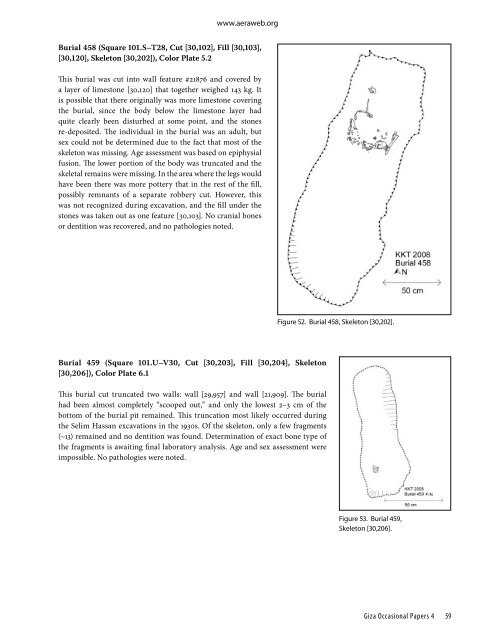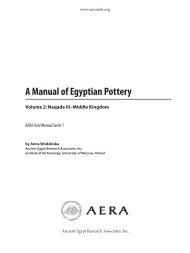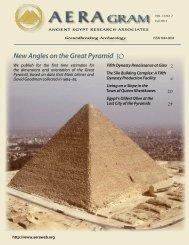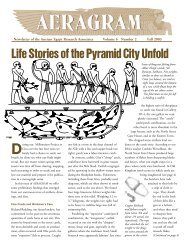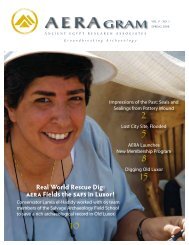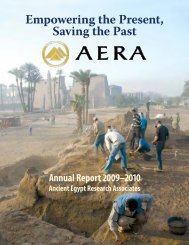The Khentkawes Town (KKT) - Ancient Egypt Research Associates
The Khentkawes Town (KKT) - Ancient Egypt Research Associates
The Khentkawes Town (KKT) - Ancient Egypt Research Associates
You also want an ePaper? Increase the reach of your titles
YUMPU automatically turns print PDFs into web optimized ePapers that Google loves.
www.aeraweb.org<br />
Burial 458 (Square 101.S–T28, Cut [30,102], Fill [30,103],<br />
[30,120], Skeleton [30,202]), Color Plate 5.2<br />
This burial was cut into wall feature #21876 and covered by<br />
a layer of limestone [30,120] that together weighed 143 kg. It<br />
is possible that there originally was more limestone covering<br />
the burial, since the body below the limestone layer had<br />
quite clearly been disturbed at some point, and the stones<br />
re-deposited. <strong>The</strong> individual in the burial was an adult, but<br />
sex could not be determined due to the fact that most of the<br />
skeleton was missing. Age assessment was based on epiphysial<br />
fusion. <strong>The</strong> lower portion of the body was truncated and the<br />
skeletal remains were missing. In the area where the legs would<br />
have been there was more pottery that in the rest of the fill,<br />
possibly remnants of a separate robbery cut. However, this<br />
was not recognized during excavation, and the fill under the<br />
stones was taken out as one feature [30,103]. No cranial bones<br />
or dentition was recovered, and no pathologies noted.<br />
Figure 52. Burial 458, Skeleton [30,202].<br />
Burial 459 (Square 101.U–V30, Cut [30,203], Fill [30,204], Skeleton<br />
[30,206]), Color Plate 6.1<br />
This burial cut truncated two walls: wall [29,957] and wall [21,909]. <strong>The</strong> burial<br />
had been almost completely “scooped out,” and only the lowest 2–3 cm of the<br />
bottom of the burial pit remained. This truncation most likely occurred during<br />
the Selim Hassan excavations in the 1930s. Of the skeleton, only a few fragments<br />
(~13) remained and no dentition was found. Determination of exact bone type of<br />
the fragments is awaiting final laboratory analysis. Age and sex assessment were<br />
impossible. No pathologies were noted.<br />
Figure 53. Burial 459,<br />
Skeleton [30,206].<br />
Giza Occasional Papers 4 59


